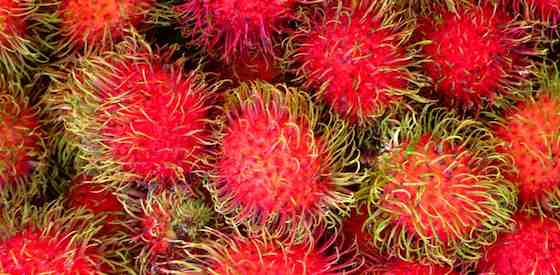- MENU
- HOME
- SEARCH
- WORLD
- MAIN
- AFRICA
- ASIA
- BALKANS
- EUROPE
- LATIN AMERICA
- MIDDLE EAST
- United Kingdom
- United States
- Argentina
- Australia
- Austria
- Benelux
- Brazil
- Canada
- China
- France
- Germany
- Greece
- Hungary
- India
- Indonesia
- Ireland
- Israel
- Italy
- Japan
- Korea
- Mexico
- New Zealand
- Pakistan
- Philippines
- Poland
- Russia
- South Africa
- Spain
- Taiwan
- Turkey
- USA
- BUSINESS
- WEALTH
- STOCKS
- TECH
- HEALTH
- LIFESTYLE
- ENTERTAINMENT
- SPORTS
- RSS
- iHaveNet.com
Environmental Nutrition

Q. Is rambutan fruit as good for you as the Internet claims it is?
A. You might have heard that rambutan is one of the hottest "superfruits" of the year, as some popular magazines and websites have proclaimed. And this exotic fruit certainly looks the part -- its ruby-colored outer surface is covered with yellowish-green, hairy tubercles (nodules), inspiring the fruit's name, which means "hair" in Malay. A close relative of lychee, rambutan (Nephelium lappaceum L.) grows on trees that can reach up to 80 feet in height, and is a treasured fruit in its native Asia. In countries like Malaysia, Thailand, the Philippines, Vietnam and Borneo, people munch on rambutan just as we do on apples.
When you peel away the hairy rind, you are left with translucent, white or rose-tinted flesh. Rambutan has been cultivated all over Asia, where it thrives in a tropical climate, but has never been successfully grown in the U.S. The most common way to enjoy rambutan is to eat it out-of-hand; tear away the rind, pop out the glistening fruit, remove the seed, and bite into its sweetness. The fruit is also enjoyed in a traditional, Asian stewed dessert, as well as preserved or canned. Rambutan seeds are used in making candles and soaps. You can find fresh and canned rambutan online, as well as at specialty stores that sell exotic, tropical produce.
Rambutan has long had a role in traditional folk healing. The fruit is used to treat stomachache and diarrhea, while the leaves are used as a poultice to relieve headaches; and the rind, bark and roots are used as folk medicine, for treating fever, for example. Today, scientists know very little about the nutritional properties of rambutan.
Rambutan Nutritional Content
(1 cup, canned in syrup, drained)
Calories: 123
Fat: 0 grams
Sodium: 17 milligrams
Carbohydrates: 31 grams
Fiber: 1.3 grams (5 percent DV)
Protein: 1 gram (2 percent DV)
Vitamin C: 7.4 milligrams (12 percent DV)
Niacin: 2 milligrams (10 percent DV)
Manganese: .5 milligrams (26 percent DV)
(DV=Daily Value)
Available at Amazon.com:
Last Child in the Woods: Saving Our Children From Nature-Deficit Disorder
WORLD | AFRICA | ASIA | EUROPE | LATIN AMERICA | MIDDLE EAST | UNITED STATES | ECONOMICS | EDUCATION | ENVIRONMENT | FOREIGN POLICY | POLITICS
Health - Getting to Know Exotic Rambutan